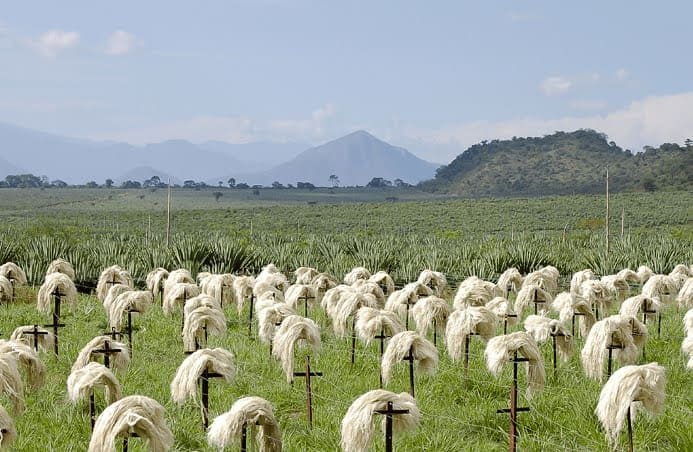Introduction:
Natural fibres are fibres that are produced by plants, animals, and geological processes. One of the most widely used natural fibers is Sisal fiber. It is also very easily cultivated. You can obtain Sisal fiber from Sisal plant. The plant, was formally known as Agave Sisalana. These plants produce rosettes of sword-shaped leaves which start out toothed, and gradually lose their teeth with maturity. Decortication is a process in which every leaf loses its long, straight fibers. During decortication, the leaves are beaten down to remove the pulp and plant material, leaving the tough fibers behind.
Sisal fiber is a high renewable source of energy , also it is fully biodegradable. Green composites are fabricated with soy protein resin which are modified with gelatin. Sisal fiber, modified soy protein resins, and composites are characterized for their mechanical and thermal properties. Sisal fibre is low maintenance with minimal wear and tear, and is exceptionally durable. It is not suitable for a smooth wall finish and also not recommended for wet areas, because it is too tough for textiles and fabrics.
The texture of sisal is fine because of which it takes dyes easily and offers the largest range of dyed colours of all natural fibres. Sisal agriculture uses zero pesticides or chemical fertilizers. It is traditionally used in making twine, rope and also dartboards because of its stiff fiber. The sisal plant has vascular tissue from which sisal fiber is manufactured (Agavesisalana). It is used in automotive friction parts (brakes, clutches), where it imparts green strength to performs, and for enhancing texture in coatings application.
Sisal Fiber Production:
Sisal fibre is made from the process of Decortication, leaves are crushed and beaten by a rotating wheel set with blunt knives, so that only fibres remain. The other parts of the leaf are washed away by water. Decorticated fibres are washed before drying in the sun or by hot air and then bleached, and combed with rotating brushes. The dried fibre represents only 4% of the total weight of the leaf. The length and diameter of sisal fibre is 80 to 120 cm in length and 0.2 to 0.4 mm respectively. The fibers can then be spun into thread for twine and textile production, or pulped to make paper products. The fibre quality depends upon moisture content so proper drying is important. To get better grades of fibre artificial drying has been found in place of sun drying. Dry fibres are machine combed and sorted into various grades, largely on the basis of the previous in-field separation of leaves into size groups.

Fiber Structure:
A sisal fibre in cross-section is built up of about 100 fibre cells. The cell walls consist of several layers of fibrillar. In the primary wall, the fibrillae have a reticulated structure. In the outer secondary wall (S1), which is located inside the primary wall, the fibrillae are arranged in spirals with a spiral angle of 40° (for sisal fibre) in relation to the longitudinal axis of the cell. The fibrillae in the inner secondary wall (S2) of sisal fibres have a sharper slope, 18° to 25°. The thin, innermost, tertiary wall has a parallel fibrillar structure and encloses the lumen. The fibrillae are, in turn, built up of micro-fibrillae with a thickness of about 20µm. The microfibrillae are composed of cellulose molecular chains with a thickness of 0.7µm and a length of a few µm.
Spinning Process:
The spinning process of sisal fiber starts with these following basic steps:
1. After extracting sisal fiber from sisal leaf by using automatic decorticator, after cleaning and drying, it is sent to sisal yarn factory.
2. The fiber must be sprayed with certain moisture and sesame oil before using in order to make sure the process goes smoothly.
3. Sisal combing machine is used to comb fiber and make the sisal sliver to be in average size and be straight.
4.after the combing process is done ,the fiber is sent to the drawing machine for drawing processing where the sisal sliver are passed through a series of rollers, thus straightening the individual fibres and making them more parallel.
5. The fibers are then sent to the spinning machine for making yarn.
6. After the above process , the yarns are rolled out of the spinning machine. And the process is complete.
Uses and Applications :
Sisal is broadly categorized under three grades and applied in various industries according to the grades.
Low-grade: cellulose and hemicellulose portion are mainly used for-
• Paper industry
• Cordage industry
Medium-grade: used in making of binder twine, ropes, bales-
• Agriculture
• Marine
• General industrial purpose
High-grade: used by blending itself with wool and acrylic for softer hand-
• Carpet industry
Reference:
• Sisal Fiber | Properties of Sisal Fiber | Uses/Application of Sisal Fiber. (n.d.). Retrieved from https://textilelearner.blogspot.com/2013/01/sisal-fiber-properties-of-sisal-fiber.html?m=1
• Aditi, P. (2018, February 18). Sisal Fibre | Sisal Fibre Production | Uses and Applications of Sisal Fibre. Retrieved from https://textilestudycenter.com/sisal-fiber/

